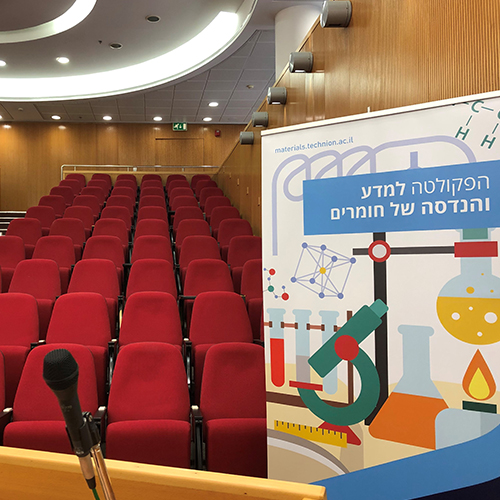
Ms. Shani Admoni - Ph.D. Candidate
17/07/2025
David Wang Auditorium, 3rd floor Dalia Meidan Bldg.
13:30
Hierarchically porous polymers with micropores (< 2 nm), mesopores (2 to 50 nm) and macropores (>50 nm) combine high specific surface areas (SSAs) with enhanced flow and diffusion for filtration, separation, adsorption, and reaction substrates. Here, hierarchically porous polymers were designed by generating emulsion-templated macroporous monoliths based on ABA, ABA-like, or CABAC block copolymers (BCPs). The atom transfer radical polymerization (ATRP) synthesized BCPs (both thermal ATRP and photoATRP) were formulated to enable the generation of hierarchical porosities. Mesopores were introduced by selectively degrading the poly(ε-caprolactone) (PCL) B blocks. The other blocks, based on polystyrene (PS) and/or poly(glycidyl methacrylate) (PGMA), formed the structural framework. Crosslinking was effected by copolymerizing with divinylbenzene (DVB) or by reacting the PGMA epoxides with tris(2-aminoethyl)amine (TAEA). Micropores were introduced by hypercrosslinking the styrenic blocks.
Three main systems were investigated. (1) P(S-co-DVB)-PCL-P(S-co-DVB): Hypercrosslinking the BCPlike monoliths led to PCL removal and micropore formation, generating an SSA of 798 m²/g, a pore volume of 0.359 cm³/g, and pores ranging from 0.6 nm to 3.8 nm. (2) PGMA-PCL-PGMA: A BPC-based
monolith was synthesized by crosslinking the PGMA. PCL was removed using 0.1 M NaOH, resulting in mesopores of 11.1 nm, an SSA of 53.9 m²/g, and a pore volume of 0.262 cm³/g. (3) PGMA-PS-PCL-PSPGMA: A BPC-based monolith was synthesized by crosslinking the PGMA. PCL was removed using 3
M NaOH and the PS was then hypercrosslinked to generate an SSA of 156.9 m²/g, a pore volume of 0.236 cm³/g, 5 nm mesopores, and 1.3 nm micropores. This research has demonstrated that hierarchical porosities in macroporous emulsion-templated monoliths based on ATRP-synthesized BCPs can be predesigned through the BCP formulation, the crosslinking strategy, and the post-synthesis modifications (etching, hypercrosslinkig).


